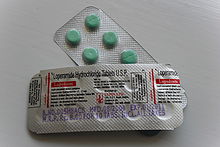Loperamide
 | |
 | |
| Clinical data | |
|---|---|
| Pregnancy category | |
| Routes of administration | oral, insufflation |
| ATC code | |
| Legal status | |
| Legal status |
|
| Pharmacokinetic data | |
| Bioavailability | Not significantly absorbed from the gut |
| Protein binding | 97% |
| Metabolism | hepatic |
| Elimination half-life | 9.1 to 14.4 hours (average 10.8 hours) |
| Identifiers | |
| |
| CAS Number |
|
| PubChem CID | |
| DrugBank | |
| ChemSpider | |
| CompTox Dashboard (EPA) | |
| ECHA InfoCard | 100.053.088 |
| Chemical and physical data | |
| Formula | C29H33ClN2O2 |
| Molar mass | 477.037 g/mol (513.506 with HCl) g·mol−1 |
| (verify) | |
Loperamide (Template:Pron-en) a synthetic piperidine derivative,[3] is an opioid drug effective against diarrhea resulting from gastroenteritis or inflammatory bowel disease. In most countries it is available generically and under brand names such as Lopex, Imodium, Dimor, Fortasec and Pepto Diarrhea Control. It was discovered at Janssen Pharmaceutica.[citation needed]
Mechanism of action
Loperamide is an opioid-receptor agonist and acts on the μ-opioid receptors in the myenteric plexus of the large intestine; by itself it does not affect the central nervous system like other opioids.
It works by decreasing the activity of the myenteric plexus, which, like morphine, decreases the tone of the longitudinal smooth muscles but increases tone of circular smooth muscles of the intestinal wall. This increases the amount of time substances stay in the intestine, allowing for more water to be absorbed out of the fecal matter. Loperamide also decreases colonic mass movements and suppresses the gastrocolic reflex.[4]
Loperamide molecules do not cross the blood-brain barrier in significant amounts, and, thus, it has no analgesic or euphoric properties. Any that do cross the blood-brain barrier are quickly exported from the brain by P-glycoprotein (Pgp), also known as multidrug resistance protein (MDR1). Tolerance in response to long-term use has not been reported.
However, loperamide has been shown to cause a mild physical dependence during preclinical studies, specifically in mice, rats, and rhesus monkeys. Symptoms of mild opiate withdrawal have been observed following abrupt discontinuation of long-term therapy with loperamide.[5][6]
Contraindications
Treatment should be avoided in the presence of fever or if the stool is bloody (dysentery).[7] It is of no value in diarrhoea caused by cholera, Shigella or Campylobacter.[7] Treatment is not recommended for patients that could suffer detrimental effects from rebound constipation. If there is a suspicion of diarrhea associated with organisms that can penetrate the intestinal walls, such as E. coli O157:H7 or salmonella, loperamide is contraindicated.
Effectiveness
Studies have shown loperamide to be more effective than diphenoxylate, attapulgite or bismuth subsalicylate for the treatment of acute diarrhea. For the treatment of chronic diarrhea, loperamide was found to be as effective as, or slightly more so than, diphenoxylate.[8]
Crossing the blood-brain barrier
Concurrent administration of P-glycoprotein inhibitors such as quinidine and its other isomer quinine (although much higher doses must be used), PPIs like omeprazole (Prilosec OTC), venlafaxine (Effexor), and even black pepper (piperine as the active ingredient) could potentially allow loperamide to cross the blood-brain barrier. It should however be noted that only quinidine with loperamide was found to produce respiratory depression, indicative of central opioid action.[9]
See also
- Simethicone - an anti-flatulent frequently combined with Loperamide in medications
- Gastroenteritis
- Traveler's diarrhea
References
- ^ loperamide medical facts from Drugs.com
- ^ SafeFetus.com
- ^ US National Cancer Institute, Drug Dictionary
- ^ Katzung, Bertram G. Basic and Clinical Pharmacology, 9th ed. (2004). ISBN 0-07-141092-9[page needed]
- ^ Yanagita T, Miyasato K, Sato J (1979). "Dependence potential of loperamide studied in rhesus monkeys". NIDA Research Monograph. 27: 106–13. PMID 121326.
{{cite journal}}: CS1 maint: multiple names: authors list (link) - ^ Nakamura H, Ishii K, Yokoyama Y; et al. (1982). "[Physical dependence on loperamide hydrochloride in mice and rats]". Yakugaku Zasshi (in Japanese). 102 (11): 1074–85. PMID 6892112.
{{cite journal}}: Explicit use of et al. in:|author=(help); Unknown parameter|month=ignored (help)CS1 maint: multiple names: authors list (link) - ^ a b Butler T (2008). "Loperamide for the treatment of traveler's diarrhea: broad or narrow usefulness?". Clinical Infectious Diseases. 47 (8): 1015–6. doi:10.1086/591704. PMID 18781871.
{{cite journal}}: Unknown parameter|month=ignored (help) - ^ "www.imodium.com" (PDF). Retrieved 2010-07-27.
- ^ Sadeque AJ, Wandel C, He H, Shah S, Wood AJ (2000). "Increased drug delivery to the brain by P-glycoprotein inhibition". Clinical Pharmacology and Therapeutics. 68 (3): 231–7. doi:10.1067/mcp.2000.109156. PMID 11014404.
{{cite journal}}: Unknown parameter|month=ignored (help)CS1 maint: multiple names: authors list (link)
